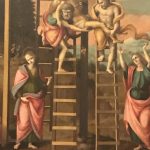
Then there are about thirty works that, exactly like the Madonna of the people, are visible to the public after years of absence.
The colors for the rooms were chosen in line with the works. The green for the Venetian painting (it is taken from the curtains and wall coverings that can be seen in many paintings of the Venetian Renaissance) and gray for Florentine painting, in homage to the pietra Serena (serene stone) the most frequently used material of the Uffizi architecture (according to a warmer and more velvety tone).
A window was also opened over the Arno River with a scenic view of the river and the hills to the south of the city, to provide the Gallery with a further point of contact with its urban context. Among the novelties, there are also the new benches arranged along the way to admire the paintings without getting tired, and the shatterproof glass for the Venus of Urbino, the Flora and the Fornarina. As for the so-called Pilastro hall, it was reassembled with the altarpieces of the Counter-Reformation: the star is the Madonna Del Popolo by Barocci, purchased by the Grand Duke Pietro Leopoldo at a high price for the Florentine collections. Close to this last masterpiece is the Noli me tangere (1581) by Lavinia Fontana.
The rooms next to the Pilastro hall were set up as studios, mainly with small works: one with sacred paintings, the other with profane subjects (above all mythological and allegorical), all visible in detail thanks to the special glass protection that allows visitors to approach and appreciate each stroke. Again, the fall of the rebel Angels by Andrea Commodi is visible: in the large sketch, a dramatic tangle of human anatomies with which the Florentine painter wanted to challenge openly the Michelangelo of the Sistine Chapel. Finally, the renovation reserved an area for dynasties: here are the portraits of the Medici made by Bronzino, including the portrait of Eleonora di Toledo with her son Giovanni.
In conclusion, Uffizi show in the best way two sectors of its collections, that of the painting of the Counter-Reformation and that of the Venetian painting, which are also among the most important in the world. It is important to highlight that very important meeting that started the movement of Counter-Reformation was the Council of Trent, which was summoned by Pope Paul III. This council functioned from 1545 to 1563, and council members met periodically. The first objective of the council was to rectify the drawbacks of the church and then start the actual counter-movement. Apart from literature, one very good form of getting people’s attention was the visual arts. To sum up, two fundamental themes have guided the new production. The search for continuity in the style of Vasari’s halls, through the study of goals and focal and perspective points in the positioning of the paintings. The creation of exhibition surfaces to support the works, surfaces that have the function of defining the new museum space separating it from the architectural space.
Carlo Marino
#carlomarinoeuropeannewsagency
